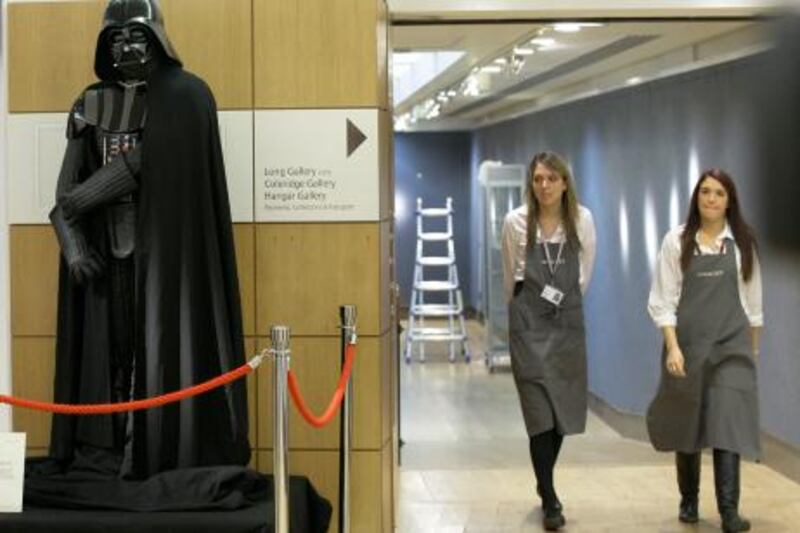Were James Bond and Darth Vader ever to face each other in a fight (and it's possible that, given time, George Lucas will come up with just such a scene), only the most foolhardy would put his money on the excessively suave spy. Yes, 007 might possess the sort of dashing jawline that doesn't have to be hidden behind a restrictive mask, an impressive array of gadget-laden Aston Martins and a licence to kill, but crucially, what he doesn't have is a massive Death Star.
While this scenario has yet to be captured on celluloid, both characters did come face-to-face in November on a totally different battlefield: the auction room floor. And it was the man on her majesty's secret service that came up trumps over the Dark Lord of the Sith. The Walther air pistol used by Sean Connery in the poster for From Russia With Love went to an unnamed bidder for $437,000 (Dh1.6m), more than 10 times its pre-sale estimate.
Meanwhile, an original Darth Vader costume - comprising his helmet, mask and armour - from The Empire Strikes Back, arguably the star of the show and expected to fetch between $250,000 and $365,000, failed to meet the reserve price and was returned to its owner. The Force, it seems, was not with the intergalactic powers that day, for a pair of Christopher Reeve's trunks from Superman III also failed to find a new home.
"The market for James Bond memorabilia is very well established," says Neil Roberts, the head of popular culture at Christie's, which organised the sale, pointing to several dedicated 007 auctions over the past couple of decades. Its success draws on the fact that at almost half a century old, the Bond franchise has managed to cross generations around the world.
Sadly for Vader, despite his snazzy black outfit racking up a lot of international interest before the sale, he's just didn't live up to expectations. "Stars Wars is a harder market to predict," suggests Roberts.
However, it seems there might have also been some uncertainty as to it origins. "The James Bond pistol had a solid provenance, whereas the Darth Vader costume had a cloud of doubt looming over its authenticity," says Darren Julien, the founder of the Los Angeles-based Julien's Auction, the world's largest company specialising solely in entertainment memorabilia. "I noticed that many collectors were suspicious of the history of the piece, so I can only assume that this is the reason that it did not sell."
Legitimate or not, the reserve price of Vader's outfit and $437,000 raised for Bond's shooter show that the memorabilia market is no small matter, and while the figures are some way off the prices seen towards the top end of the art market, it's appreciating considerably.
"[The memorabilia market] has shown a steady growth both in turnover and the number of sales and buyers," says Stephen Maycock, Bonham's consultant specialist for rock'n'roll and film memorabilia. Among the most famous pieces of film memorabilia are the ruby slippers from The Wizard of Oz, of which apparently four are floating about. In 2000, one pair went for $660,000, not a bad mark up from the $150,000 they were bought for in 1988.
In fact, it could be argued that Dorothy's sparkly footwear helped kick off the craze for movie prop collectors. Back in 1970, MGM Studios sold off the contents of seven sound stages, including more than 350,000 costumes alone, to an auctioneer, who put them all under the hammer.
"Marilyn Monroe dresses and Elvis clothing articles were sold for around $1,000," says Julien, adding that this was a "mere fraction" of their current value. Among items such as Johnny Weissmuller's Tarzan loincloth and the time machine from the 1960 dramatisation of HG Wells's book, was one pair of Dorothy's ruby slippers, the centrepiece of the auction, which went for a then-unheard-of $15,000.
Since then, the market has grown so much that the catalogue from the 1970 auction is now considered a collector's item in its own right. In the early 1990s, both Christie's and Sotheby's started putting their considerable weight behind entertainment auctions, and it continued to grow from there. "Christie's sale of items from the estate of Marilyn Monroe in 1999, and the James Bond sale in 2001 certainly went some way to demonstrating how strong such collecting fields were," says Roberts.
Despite prices heading steadily upwards, the names at the top of the pile have remained relatively unchanged. Along with Monroe and Bond, A-list celebrities such as Audrey Hepburn, Steve McQueen, The Beatles, Elvis Presley and James Dean are among the most reliable to sell. And the top prices generally go to important and well-documented moments in their careers.
For example, the white dress Monroe wore while singing happy birthday to John F Kennedy, an incident that was not only one of the icon's last public appearances but added to speculation about an affair between the two, was sold for more than $1 million at Christie's Monroe Estate sale in 1999. In 2008, the drumskin that featured on the album cover for The Beatles' Sgt Pepper's Lonely Hearts Club Band also fetched more than $1 million.
Interestingly, it seems music items are more collectable than Hollywood. Recently, there has been a spate of sales of original lyrics. Bob Dylan's handwritten scribbles that became The Times they are a'Changin fetched more than $400,000 just two months ago, while John Lennon's lyrics for Give Peace a Chance were sold for double that in 2008. The fact that he wrote them during his legendary 1969 bed-in protest with Yoko Ono no doubt only added to their value. A Day in the Life, however, topped that in June 2010, going for $1.2 million, but this wasn't enough to beat the piece of paper on which Lennon had scrawled the lyrics for All You Need is Love, which sold in 2005 for $1.25 million.
Being dead and a Beatle appears to be a guaranteed money-spinner on the auction-room floor. Way back in 1981 Sotheby's in London held the first auction dedicated to rock'n'roll memorabilia by a leading auction house. "From this very first sale, it was clear that The Beatles were the dominant name and this is something that hasn't changed," says Maycock of Bonham's.
Lennon's album Two Virgins with Ono may have been awful, but the necklace he wore on the cover sold for more than $500,000 in 2008 (granted, it was the only thing John was wearing on the cover). The classic Gibson guitar played by George Harrison on Revolver and Lennon on The White Album sold for $567,500. Famously, in 2000 George Michael won the bidding for the piano on which Lennon had composed Imagine for the princely sum of $2.1 million. Less famously, a lock of Lennon's hair, as preserved by a former hairdresser of his, was sold for $24,000 in 2007. Maycock says that he sold one of the baths removed from Lennon's former home.
Which leads us delightfully on to the more wacky sides of entertainment memorabilia. "The most unusual sale we've seen is William Shatner's kidney stone, for $75,000," says Darren Julien, adding that his auction house has also recently overseen the auctioning of X-rays of Marilyn Monroe's chest for $45,000 and Albert Einstein's brain for $38,000. On a more macabre note, the same Icons and Idol's event in December that sold the X-rays also offloaded two of Monroe's empty prescription bottles for $18,750.
Only the Marilyn-obsessed (or the slightly sick) would relish owning the pill bottles of someone who may well have died from an overdose (depending on which conspiracy theory you subscribe to), but that's how many collectors shape their collections, focusing on one individual star.
"Most important is that you buy what you love, and the best that you can afford," advises Roberts. "Collecting is about quality, not quantity."





